| Administrator Handbook | Table of contents |
|
LoriotPro is what is commonly known as an NMS or Network Management System. In other words, it is able to monitor and manage everything that constitutes an Information System (IS), including not only communication equipments such as routers, switches, and hubs, but also servers, printers, and applications.
LoriotPro can also help you to manage smart infrastructure using remote IP devices, video camera, intrusion detection sensor, power supply sensor, humidity sensor etc.
LoriotPro is a major improvement of the well-known Loriot Freeware product, a management and monitoring product that helps administrators to keep their entire Information System (IS) up and running.
LoriotPro combines ease of use with powerful features. It helps you to monitor the status of your IS resources, warns you of problems, provides a variety of reports, focuses on specific equipment, and much more.
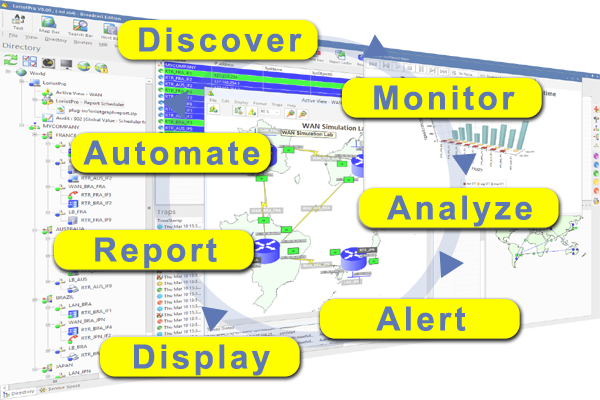
LoriotPro is scalable and includes the tools necessary for monitoring a single site as well as a large company with multiple sites. With LoriotPro, network administrators have a true monitoring center of all IS resources, which helps them to reduce downtime and allocate resources as needed.
LoriotPro Version 8 runs on the following Microsoft operating systems:
LoriotPro is available in different editions, each edition has different technical characteristics and has a different price.
LoriotPro is fully autonom and do not need any other internal or external Server of service, Database, WEB server, etc. LoriotPro installation takes few minutes and can start to monitor your network right away.
It uses the advanced graphical capabilities of the Microsoft Windows operating system by providing an intuitive an powerful graphical user interface.
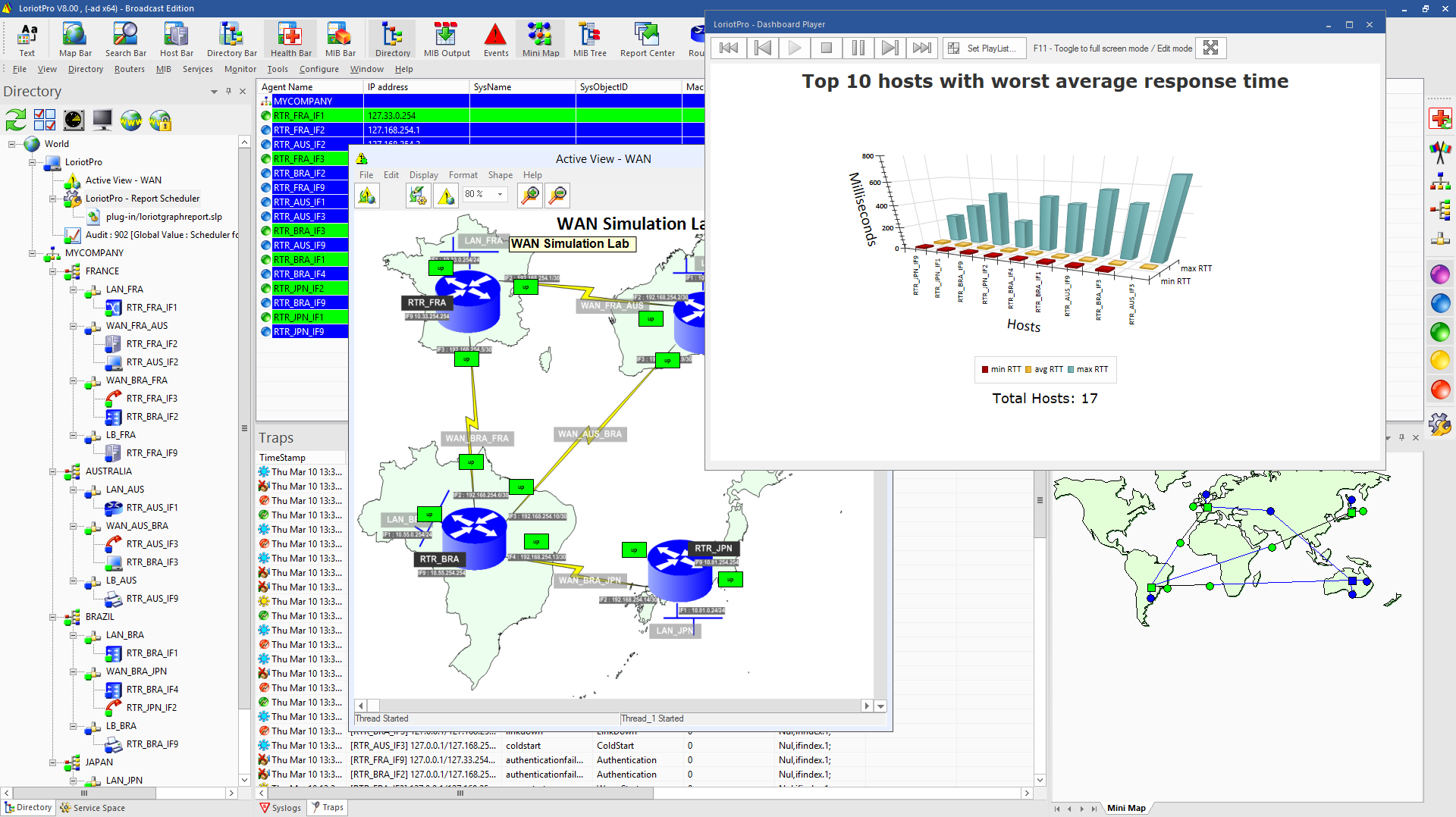
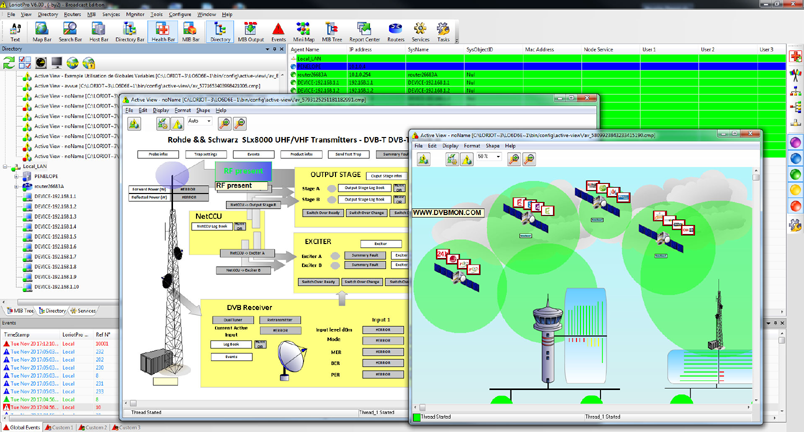
Map of the company network
LoriotPro and IETF standards
The primary, though not the only protocol that LoriotPro uses is Simple Network Management Protocol (SNMP) defined by the Internet Engineering Task Force (IETF) in Requests for Comments (RFCs). LoriotPro is fully compatible with SNMP versions 1 and 2c, and partially compatible with version 3.
To provide fast and direct access to your IS entities, LoriotPro displays them in various ways, such as in a graphical map, in a directory, or in the Health� Control Center. You can also use advanced search tools to locate IS entities.
The Loriotpro directory
The LoriotPro directory is graphically shown as a tree. This directory is called the LoriotPro Directory Service (LDS) or simply, the Directory. The Organizational Tree displays Directory objects. The LoriotPro Directory Service (LDS) is the nerve center of the product. It gives the administrator the power and a user-friendly way of quickly handling IS devices. The LDS is built on a completely new directory structure based on an object-oriented approach. An Object can be anything that needs to be manipulated (server, country, service, graph, interface, and so on) including those already defined in the Management Information Base (MIB).
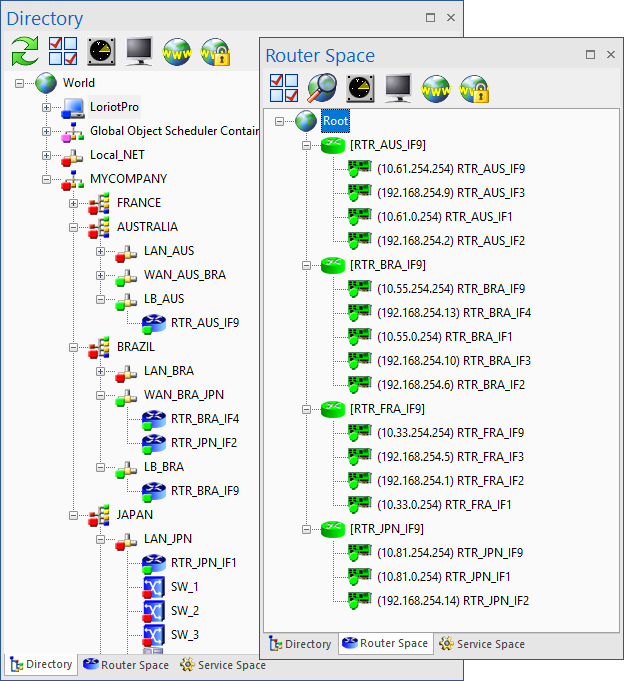
LoriotPro Directory Services: LDS
The Directory is active and can be used by external programs (plug-ins). Plug-ins must follow the development rules described in the document dealing with Software Development Kits (SDKs).
Each IS entity, called host in our terminology, that has an IP address is placed in the Directory as a leave object. When you select a host in the tree structure, you can attach tasks or functions to that host. You can use the predefined functions that exist in LoriotPro, such as graphs, VU meters, and reports, or you can also use scripts and functions that an SDK allows you to customize.
LoriotPro displays a dynamic view of IS status by offering numerous visual indicators within a user-friendly Graphical User Interface (GUI). LoriotPro integrates innovative concepts to provide a new way of representing the enterprise network. The conventional topological representation is included as well as a very new logical view in an organizational tree, which contains the enterprise structure and all its active network and host components.
For example, you can place multiple country containers at the top of the tree, each one containing multiple main plants or subsidiaries. In each location, you set the branches that contain network equipment, systems, printers, and so on. In fact, you can organize the logic of your setup any way you want.
Continuous monitoring
The Polling Process sends regular requests to devices to obtain their current status. This innovative process integrates a mechanism of conditional polling that gives the administrator complete control. The Polling process update the status of the object located in the directory, in the map, in the Health Control Center and optionnaly in the Active View.
![]()
The five status color give to the administrator and immediate state of the reachability of the host.
Topological View
The Graphical Topology View is LoriotPro’s most visually meaningful element. It gives a complete and dynamic view of the network and attached devices. Any change in a device’s status is immediately brought to your attention by a color change in its icon in this view. The change could be the failure of a communication link or a process running a specific device, for example. A smaller version of the map provides a zoomed-out view, giving you the ability to understand at a glance the status of the network.

Graphical view of the IP network
The Active View
Active View are other ways of supervsing your devices and equipments. With Active Views that represent maps, equipments, rooms, campus, you could have user friendly representations that show dynamically the status of your critical ressources.

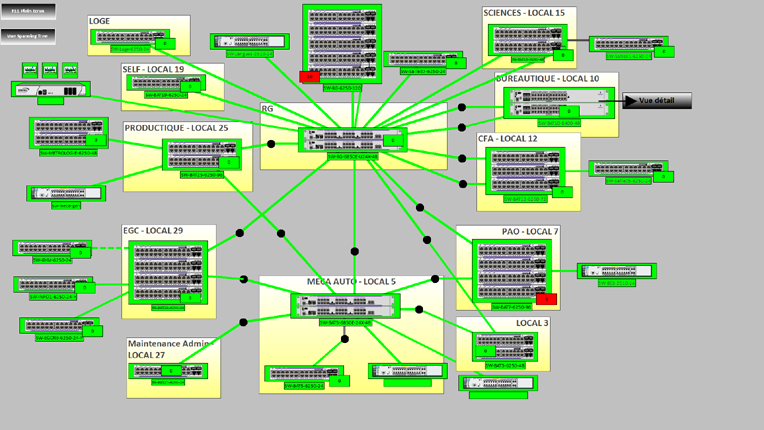
On each Active View object you can attach a user defined contextual menu with
your preferred actions. you can for example start a Plug-in, load another view,
open a report ...
Performance management
The basic principle of LoriotPro is based on the native capability of the devices in the IS. You can gather a huge amount of information about the configuration and status of IS devices by sending SNMP requests to them via a private Internet Protocol (IP) network or the Internet. The information that is collected about the devices can be displayed in various ways such as histograms, gauges, maps, curves, tables, reports, and so on.
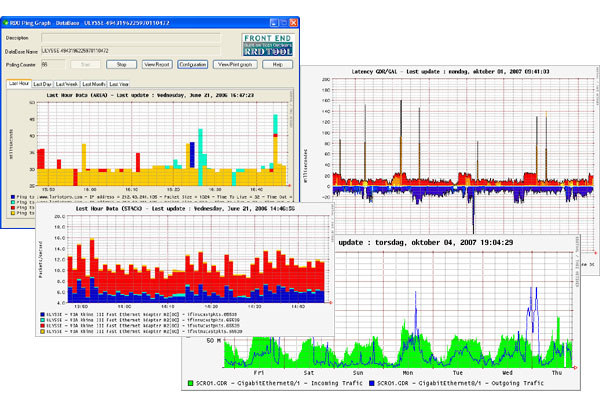
Network and resource discovering
You do not need to fill manually the directory with the hundreds
of devices that are in your network. The discover process do it for you. LoriotPro
provides two ways for collecting a complete view of your network infrastructure.
A discover process based on SNMP that uses the information loacted in your IP
routers (networks, hosts, routing table, ARP table).
The Automatic Discovery Process locates devices that are connected
to the network only minutes after installation of LoriotPro and provides a complete
view of the IS. The power and advanced features of this process give the administrator
precision control over the domain he administers. A IP scanner that is able
to basically browse range of IP addresses, detect live host, and update your
directory.
Event Management
The event management is the corner stone of a good NMS. It is a critical
functionnality for any administrator to be notify as fast as possible of any
hardware or software failure. LoriotPro provides support of events, alarms and
notifications, and advanced filter and trigger capabilities that allow to define
a powerful event management policy.
The Event Management Process collects all events that come from devices (traps) and all events that LoriotPro generates internally or that come from another LoriotPro agent. This process can then send alerts by e-mail, beeper, Short Message Service (SMS), and so on to warn the administrator.
 Real time view windows of alerts
Real time view windows of alerts
LoriotPro can also receive event messages (called traps) from managed devices and warn the administrator of exceptions or problems by playing a sound, sending a console message, or by highlighting or blinking an icon in a map. Traps report when an exception occurs or a preset threshold has been exceeded.
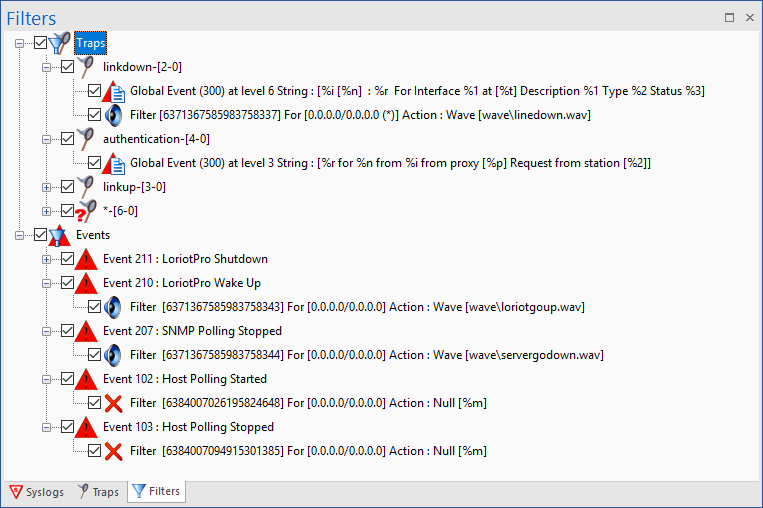
Alert associated filter definitions windows
Coming with the version 4, the accounting of Event types and Trap types is now possible. You can filter from the display repetitive events, trigger action on a specific event type recurrence, use these counters in Active View and change the color of an Active View object on a specific trap occurence.
WEB Remote access
The Remote Control Process uses an integrated Web server to allow remote access to the LoriotPro system from any Web navigator and gives an instant view of the IS’s status.
Reporting
Reports are available under WEB format either locally or from the Remote WEB console. A powerful scripting language allows you to create your own report with internal dynamic value coming from SNMP request. Displaying a report is an immediat view on device status or configuration. This is an ideal tool for inventory management too.
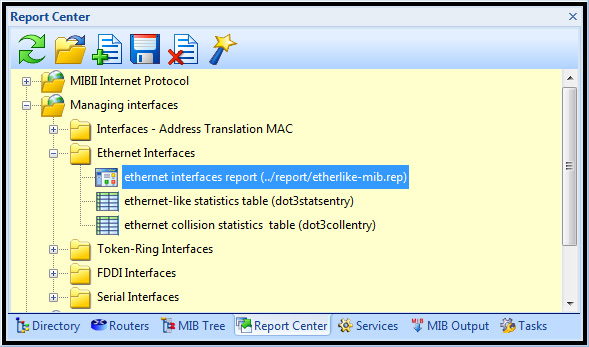

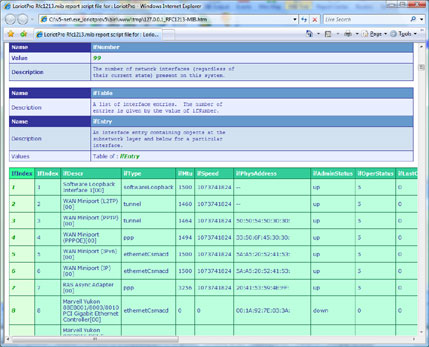
Report generation containing graphics
MIB support
SNMP management is based on the well known MIB file. MIB files describes what can be monitored in a particular device. The MIB files are not very easy to understand and manipulate. LoriotPro provides various representation and wizard that help the administrator to find MIB objet and their instance. A reduce view of the MIB tree facilitate the exploitation of the MIB object.
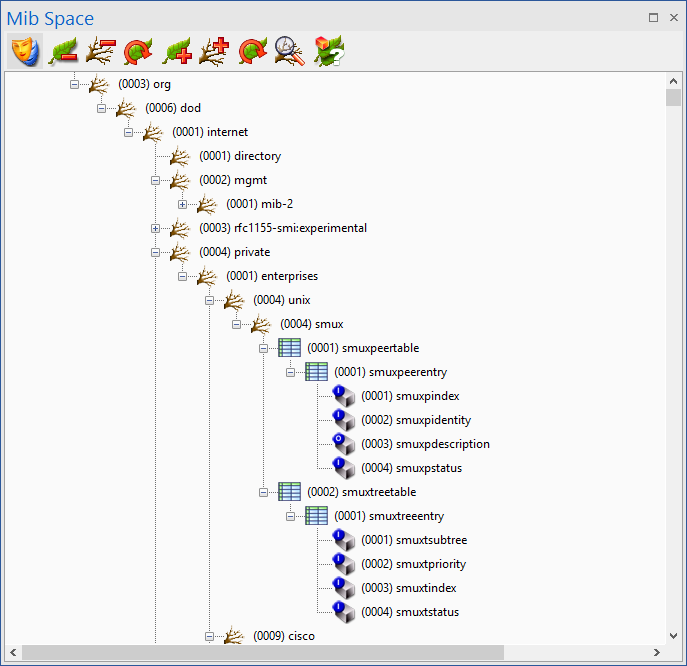
Another feature of LoriotPro is the MIB compiler and it capability of handling MIB files and duplicate objets name. With LoriotPro you manage MIB object by their short name.
Modules additionnels (PLUG-IN)
A Plug-in is a separate code module that behaves as though it is part of the LoriotPro software.
Plugin is used to perform MIB object values acquisition via SNMP on a Host or a group of host, to process them, to display them in various ways and eventually to generate alarms.
Plug-in provides a lot of flexibility in the use of LoriotPro. They are loaded on demand and then operate in the background. The principle of Plug-in allows especially to increase functionality LoriotPro and opens the platform LoriotPro to the development of programs by third parties. LoriotPro is capable of running hundreds of plug-in at the same time, thanks to the Windows multiThreading capabilities.
The list of plug-in available and their usefulness is presented in Chapter Modules additionnels (Plugin)
The plug-in modules that are compatible and tested by LUTEUS are identified by the logo below:
 www.loriotpro.com
www.loriotpro.com |
|